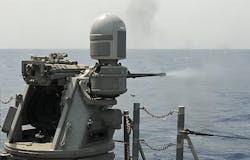Raytheon and Lockheed Martin move forward in developing smart bullets for surface ship defense
ARLINGTON, Va., 23 Feb. 2016. Two U.S. defense prime contractors are moving forward with a military surface ship defense research project to design medium-caliber smart bullets that enable Navy surface warships to ward off attacks from aircraft, missiles, and fast attack boats bearing down from many different directions at once.
Officials of the U.S. Defense Advanced Research Projects Agency (DARPA) in Arlington, Va., awarded two contract modifications Friday for the second phase of the Multi Azimuth Defense Fast Intercept Round Engagement System (MAD-FIRES) program.
DARPA awarded a $17.2 million MAD Fires contract to the Raytheon Co. Missile Systems segment in Tucson, Ariz., and an $8.4 million MAD FIRES contract to the Lockheed Martin Corp. Missiles and Fire Control segment in Grand Prairie, Texas.
Attacks by unmanned aerial vehicles (UAVs), missiles, small planes, fast in-shore attack boats, and other maritime threats pose a deadly and evolving threat to ships and other maritime vessels, DARPA officials say.
These kinds of threats demand that Navy ships have access to leaded -edge defensive capabilities -- specifically an ability to engage multiple and diverse targets coming from a range of directions and do so rapidly and with high precision using current close-range shipboard gun systems.
Related: Navy approaches industry for electro-optical dome of imaging over surface warships
The goal of MAD-FIRES is to develop enabling technologies for a medium-caliber guided projectile that would combine the guidance, precision, and accuracy of missiles with the speed, rapid-fire capability, and large ammunition capacity of bullets.
MAD-FIRES aims to advance the state-of-the-art in defensive gun systems by creating a new, low-cost technological foundation for guided, gun-launched projectiles.
The program seeks to incorporate enhanced ammunition rounds able to alter their flight path in real time to stay on target, and a capacity to target, track, and engage several fast-approaching targets simultaneously and re-engage any targets that survive the initial engagement.
Raytheon and Lockheed Martin previously won MAD Fires phase-0 contracts will define concepts and establish a modeling and simulation baseline for the program. The contracts announced Friday involve phase-1 of the MAD-Fires program, which involves preliminary risk-reduction demonstrations.
Related: Planned capabilities may give small surface warships the reach and punch of larger ships
It will during this phase that DARPA researchers decide whether to proceed to Phases 2 and 3. Phase 2 would further advance MAD-FIRES design work and conduct additional risk reduction demonstrations. Phase 3 would demonstrate the final MAD-FIRES technologies in an operational military environment.
Friday's contract modification would bring Raytheon's total MAD-FIRES contract value to $18.9 million. Lockheed Martin's modification would bring the value of the company's MAD-FIRES contract to $14.9 million -- of which Lockheed Martin is responsible for paying $5 million, with DARPA picking up the remainder.
On these contract modification Raytheon will do the work in Tucson, Ariz.; Cambridge, Mass.; Gainesville, Va.; East Amherst, N.Y.; and McKinney, Texas. Lockheed Martin will do its work in Grand Prairie, Texas; and Gainesville, Va. Both companies will be finished by February 2017.
For more information contact Raytheon Missile Systems online at www.raytheon.com, Lockheed Martin Missiles and Fire Control at www.lockheedmartin.com/us/mfc, or DARPA at www.darpa.mil.

